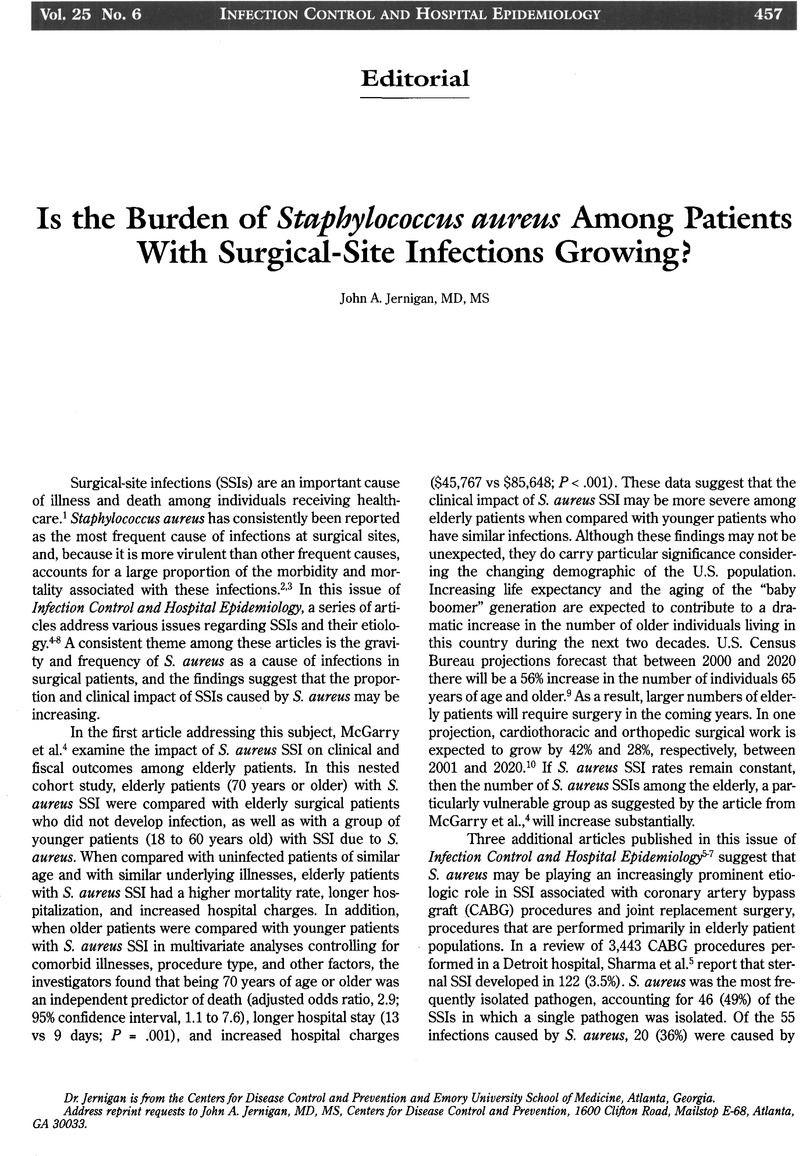Crossref Citations
This article has been cited by the following publications. This list is generated based on data provided by Crossref.
Harberg, Denise
2005.
Society for Healthcare Epidemiology of America Guideline Approach Works to Control a Methicillin-ResistantStaphylococcus aureusOutbreak.
Infection Control & Hospital Epidemiology,
Vol. 26,
Issue. 2,
p.
115.
Grossart, B.
2006.
Praktische Krankenhaushygiene und Umweltschutz.
p.
327.
Harbarth, S. J.
2006.
Praktische Krankenhaushygiene und Umweltschutz.
p.
62.
Anderson, Deverick J.
Chen, Luke F.
Schmader, Kenneth E.
Sexton, Daniel J.
Choi, Yong
Link, Katherine
Sloane, Rick
and
Kaye, Keith S.
2008.
Poor Functional Status as a Risk Factor for Surgical Site Infection Due to Methicillin-ResistantStaphylococcus aureus.
Infection Control & Hospital Epidemiology,
Vol. 29,
Issue. 9,
p.
832.
Mueller, Shawn Westadt
and
Krebsbach, Larry E.
2008.
Impact of an antimicrobial-impregnated gauze dressing on surgical site infections including methicillin-resistant Staphylococcus aureus infections.
American Journal of Infection Control,
Vol. 36,
Issue. 9,
p.
651.
Zanetti, Giorgio
2008.
Antibiotic Policies: Fighting Resistance.
p.
237.
Strelczyk, Kim
2008.
SSIs.
OR Nurse,
Vol. 2,
Issue. 8,
p.
10.
Muder, Robert R.
Cunningham, Candace
McCray, Ellesha
Squier, Cheryl
Perreiah, Peter
Jain, Rajiv
Sinkowitz-Cochran, Ronda L.
and
Jernigan, John A.
2008.
Implementation of an Industrial Systems-Engineering Approach to Reduce the Incidence of Methicillin-ResistantStaphylococcus aureusInfection.
Infection Control & Hospital Epidemiology,
Vol. 29,
Issue. 8,
p.
702.
Kirby, John P.
and
Mazuski, John E.
2009.
Prevention of Surgical Site Infection.
Surgical Clinics of North America,
Vol. 89,
Issue. 2,
p.
365.
Strelczyk, Kim
2009.
SSIs.
Nursing Management (Springhouse),
Vol. &NA;,
Issue. ,
p.
13.
Naikare, Hemant
Ramachandran, Akhilesh
Goad, David
Clarke, Jean
and
Clarke, Cyril
2009.
CE‐based detection of methicillin‐resistant Staphylococcus aureus.
ELECTROPHORESIS,
Vol. 30,
Issue. 3,
p.
472.
Anderson, Deverick J.
and
Kaye, Keith S.
2009.
Staphylococci in Human Disease.
p.
346.
Anderson, Deverick J.
and
Kaye, Keith S.
2009.
Staphylococcal Surgical Site Infections.
Infectious Disease Clinics of North America,
Vol. 23,
Issue. 1,
p.
53.
Anderson, Deverick J.
Arduino, Jean Marie
Reed, Shelby D.
Sexton, Daniel J.
Kaye, Keith S.
Grussemeyer, Chelsea A.
Peter, Senaka A.
Hardy, Chantelle
Choi, Yong II
Friedman, Joelle Y.
and
Fowler, Vance G.
2010.
Variation in the Type and Frequency of Postoperative Invasive Staphylococcus aureus Infections According to Type of Surgical Procedure.
Infection Control & Hospital Epidemiology,
Vol. 31,
Issue. 7,
p.
701.
Nguyen, Megan H.
Eells, Samantha J.
Tan, Jennifer
Sheth, Corinne T.
Omari, Bassam
Flores, Margarita
Wang, Jeffrey
and
Miller, Loren G.
2011.
Prospective, Open-Label Investigation of the Pharmacokinetics of Daptomycin during Cardiopulmonary Bypass Surgery.
Antimicrobial Agents and Chemotherapy,
Vol. 55,
Issue. 6,
p.
2499.
Abi-Haidar, Youmna
Gupta, Kalpana
Strymish, Judith
Williams, Sandra A.
and
Itani, Kamal M.F.
2011.
Factors Associated with Post-Operative Conversion to Methicillin-ResistantStaphylococcus AureusPositivity or Infection in Initially MRSA-Negative Patients.
Surgical Infections,
Vol. 12,
Issue. 6,
p.
435.
Bucher, Brian T
Warner, Brad W
and
Dillon, Patrick A
2011.
Antibiotic prophylaxis and the prevention of surgical site infection.
Current Opinion in Pediatrics,
Vol. 23,
Issue. 3,
p.
334.
Khairy, Gamal A.
Kambal, Abdelmageed M.
Al-Dohayan, Abdullah A.
Al-Shehri, Mohammed Y.
Zubaidi, Ahmad M.
Al-Naami, Mohammed Y.
AlSaif, Faisal A.
Al-Obaid, Omar A.
Al-Saif, Abdulaziz A.
El-Farouk, Omer Y.
and
Al-Abdulkarim, Amal A.
2011.
Surgical Site Infection in a Teaching Hospital: A Prospective Study.
Journal of Taibah University Medical Sciences,
Vol. 6,
Issue. 2,
p.
114.
Scheithauer, S.
Häfner, H.
and
Lemmen, S.W.
2012.
Das Keimspektrum von heute – gegen wen kämpfen wir?.
Der Orthopäde,
Vol. 41,
Issue. 1,
p.
6.
Young, Pang Y.
and
Khadaroo, Rachel G.
2014.
Surgical Site Infections.
Surgical Clinics of North America,
Vol. 94,
Issue. 6,
p.
1245.



